Financial Derivatives and Portfolio Management Assignment
VerifiedAdded on 2023/05/28
|23
|2417
|187
Homework Assignment
AI Summary
This comprehensive finance assignment delves into various aspects of financial management, including portfolio construction, risk analysis, and valuation techniques. It begins with an analysis of market portfolios, calculating standard deviations and applying the Capital Asset Pricing Model (CAPM) to determine expected returns. The assignment then explores equity portfolios, evaluating their performance based on different metrics and assessing the impact of diversification. Bond valuation is another key area, with calculations of Macaulay and modified duration, and the analysis of bond yields and price changes. The use of financial derivatives, such as futures and options, is also examined, including forward contracts, put options, and the Black-Scholes model. Additionally, the assignment considers the impact of debt-to-equity ratios on the rate of return and provides insights into currency exchange rate risk and hedging strategies. Overall, this assignment provides a detailed overview of financial concepts and practical applications, equipping students with essential knowledge for financial decision-making.
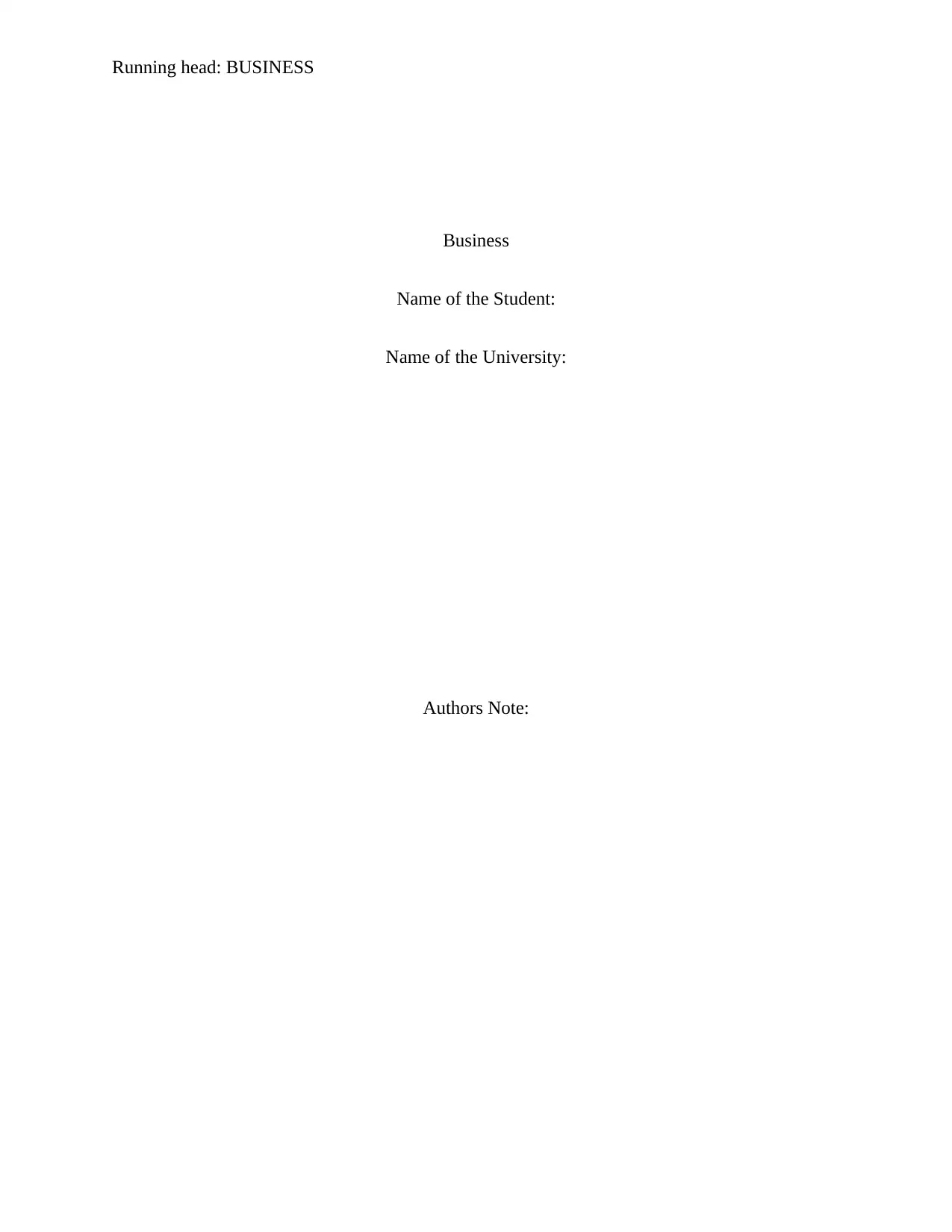
Running head: BUSINESS
Business
Name of the Student:
Name of the University:
Authors Note:
Business
Name of the Student:
Name of the University:
Authors Note:
Paraphrase This Document
Need a fresh take? Get an instant paraphrase of this document with our AI Paraphraser
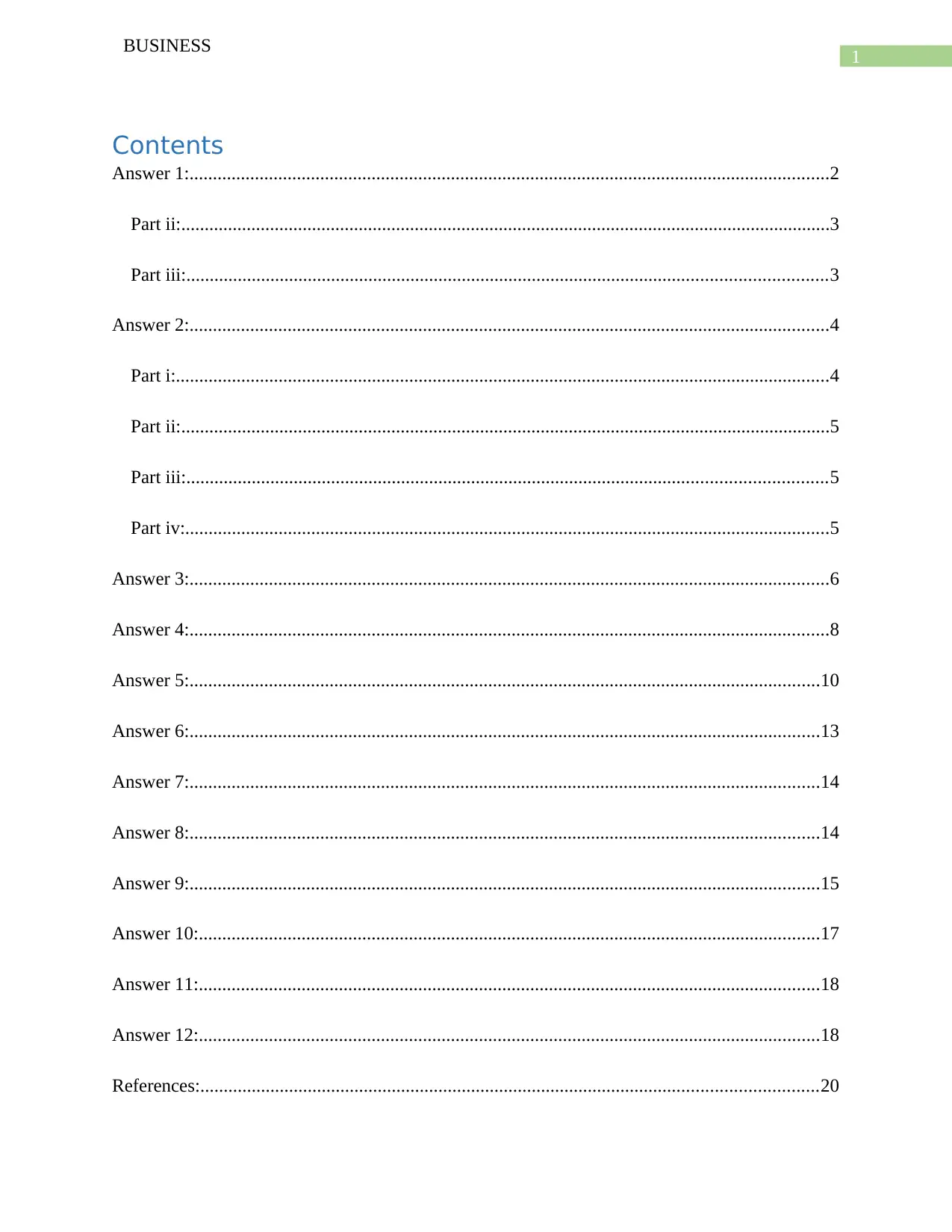
1
BUSINESS
Contents
Answer 1:.........................................................................................................................................2
Part ii:...........................................................................................................................................3
Part iii:.........................................................................................................................................3
Answer 2:.........................................................................................................................................4
Part i:............................................................................................................................................4
Part ii:...........................................................................................................................................5
Part iii:.........................................................................................................................................5
Part iv:..........................................................................................................................................5
Answer 3:.........................................................................................................................................6
Answer 4:.........................................................................................................................................8
Answer 5:.......................................................................................................................................10
Answer 6:.......................................................................................................................................13
Answer 7:.......................................................................................................................................14
Answer 8:.......................................................................................................................................14
Answer 9:.......................................................................................................................................15
Answer 10:.....................................................................................................................................17
Answer 11:.....................................................................................................................................18
Answer 12:.....................................................................................................................................18
References:....................................................................................................................................20
BUSINESS
Contents
Answer 1:.........................................................................................................................................2
Part ii:...........................................................................................................................................3
Part iii:.........................................................................................................................................3
Answer 2:.........................................................................................................................................4
Part i:............................................................................................................................................4
Part ii:...........................................................................................................................................5
Part iii:.........................................................................................................................................5
Part iv:..........................................................................................................................................5
Answer 3:.........................................................................................................................................6
Answer 4:.........................................................................................................................................8
Answer 5:.......................................................................................................................................10
Answer 6:.......................................................................................................................................13
Answer 7:.......................................................................................................................................14
Answer 8:.......................................................................................................................................14
Answer 9:.......................................................................................................................................15
Answer 10:.....................................................................................................................................17
Answer 11:.....................................................................................................................................18
Answer 12:.....................................................................................................................................18
References:....................................................................................................................................20

2
BUSINESS
BUSINESS
⊘ This is a preview!⊘
Do you want full access?
Subscribe today to unlock all pages.

Trusted by 1+ million students worldwide
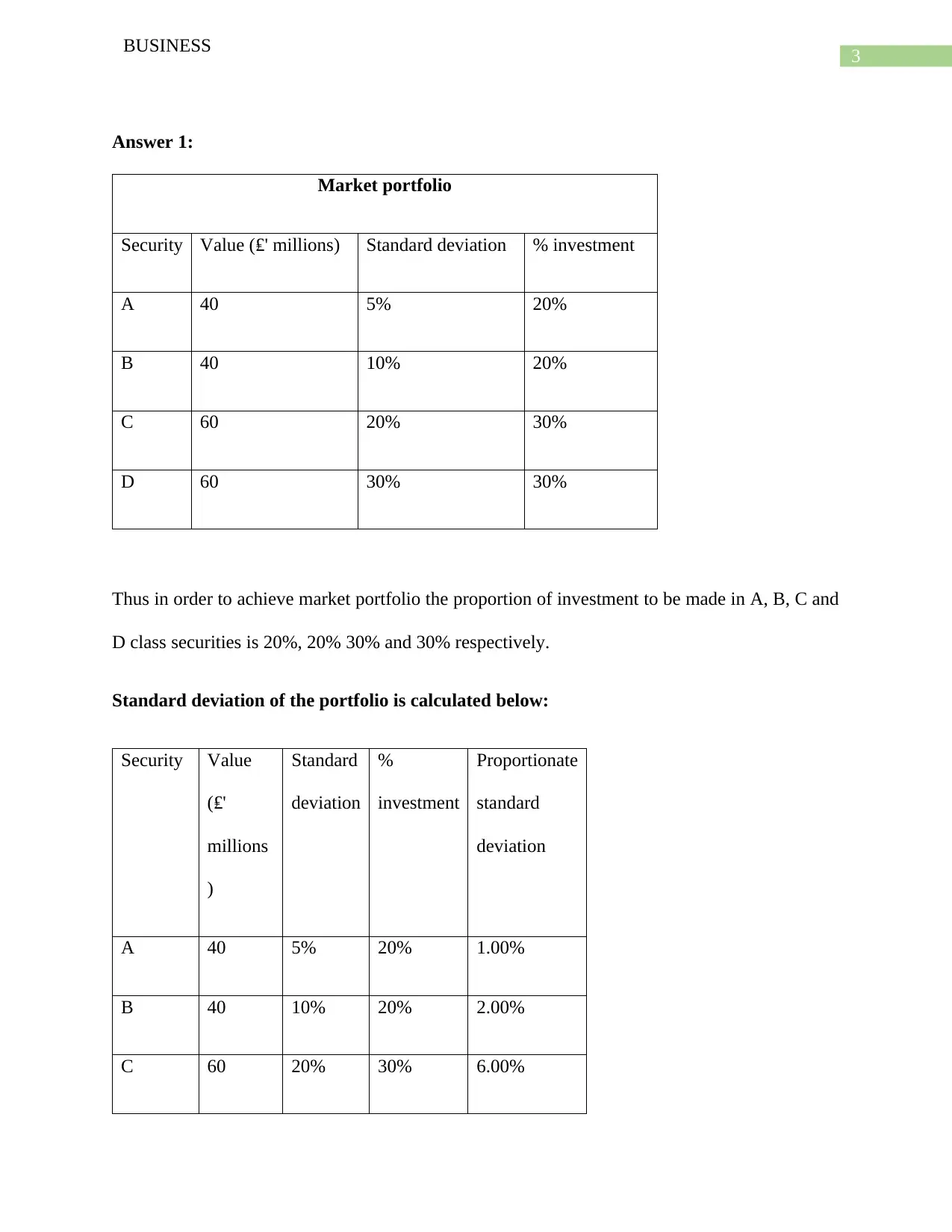
3
BUSINESS
Answer 1:
Market portfolio
Security Value (₤' millions) Standard deviation % investment
A 40 5% 20%
B 40 10% 20%
C 60 20% 30%
D 60 30% 30%
Thus in order to achieve market portfolio the proportion of investment to be made in A, B, C and
D class securities is 20%, 20% 30% and 30% respectively.
Standard deviation of the portfolio is calculated below:
Security Value
(₤'
millions
)
Standard
deviation
%
investment
Proportionate
standard
deviation
A 40 5% 20% 1.00%
B 40 10% 20% 2.00%
C 60 20% 30% 6.00%
BUSINESS
Answer 1:
Market portfolio
Security Value (₤' millions) Standard deviation % investment
A 40 5% 20%
B 40 10% 20%
C 60 20% 30%
D 60 30% 30%
Thus in order to achieve market portfolio the proportion of investment to be made in A, B, C and
D class securities is 20%, 20% 30% and 30% respectively.
Standard deviation of the portfolio is calculated below:
Security Value
(₤'
millions
)
Standard
deviation
%
investment
Proportionate
standard
deviation
A 40 5% 20% 1.00%
B 40 10% 20% 2.00%
C 60 20% 30% 6.00%
Paraphrase This Document
Need a fresh take? Get an instant paraphrase of this document with our AI Paraphraser
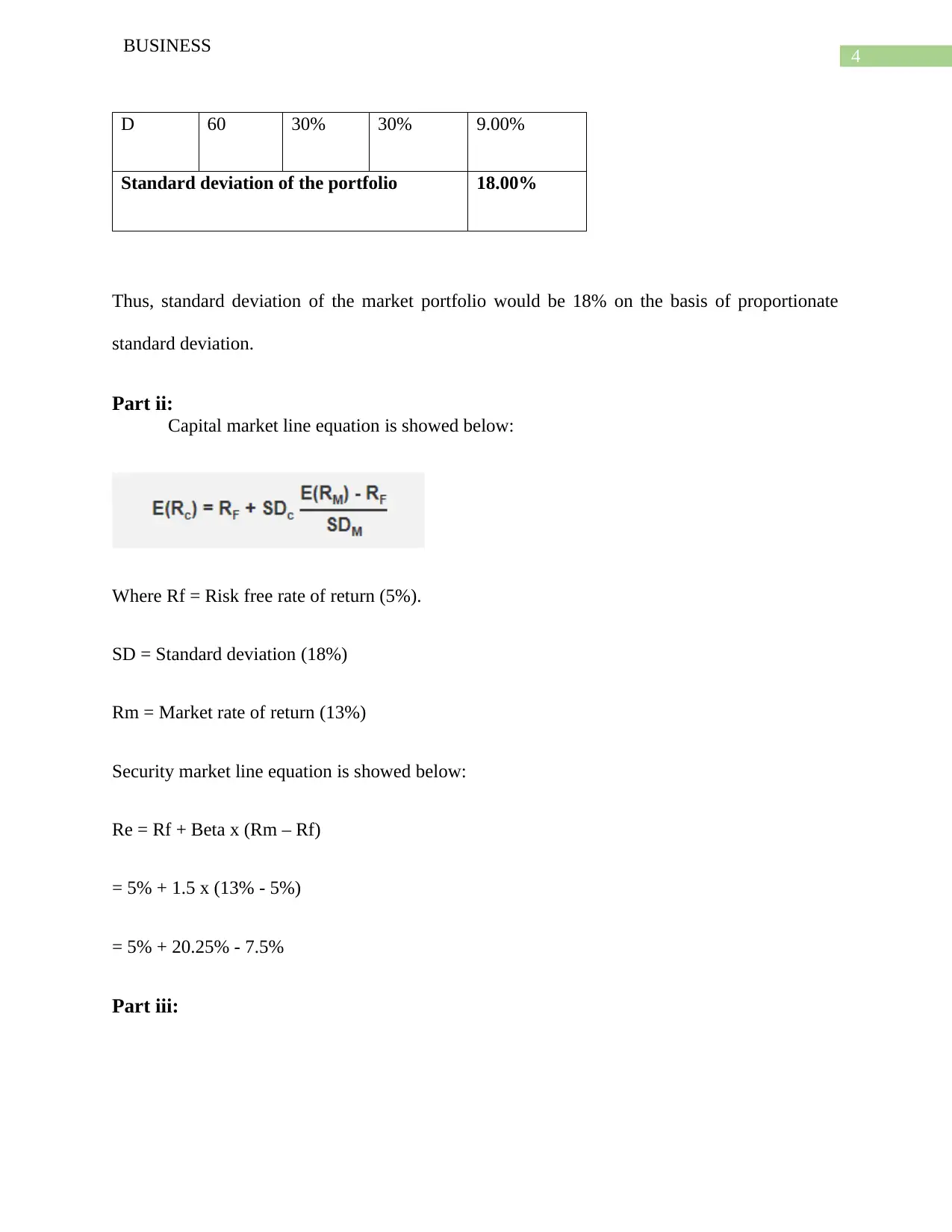
4
BUSINESS
D 60 30% 30% 9.00%
Standard deviation of the portfolio 18.00%
Thus, standard deviation of the market portfolio would be 18% on the basis of proportionate
standard deviation.
Part ii:
Capital market line equation is showed below:
Where Rf = Risk free rate of return (5%).
SD = Standard deviation (18%)
Rm = Market rate of return (13%)
Security market line equation is showed below:
Re = Rf + Beta x (Rm – Rf)
= 5% + 1.5 x (13% - 5%)
= 5% + 20.25% - 7.5%
Part iii:
BUSINESS
D 60 30% 30% 9.00%
Standard deviation of the portfolio 18.00%
Thus, standard deviation of the market portfolio would be 18% on the basis of proportionate
standard deviation.
Part ii:
Capital market line equation is showed below:
Where Rf = Risk free rate of return (5%).
SD = Standard deviation (18%)
Rm = Market rate of return (13%)
Security market line equation is showed below:
Re = Rf + Beta x (Rm – Rf)
= 5% + 1.5 x (13% - 5%)
= 5% + 20.25% - 7.5%
Part iii:
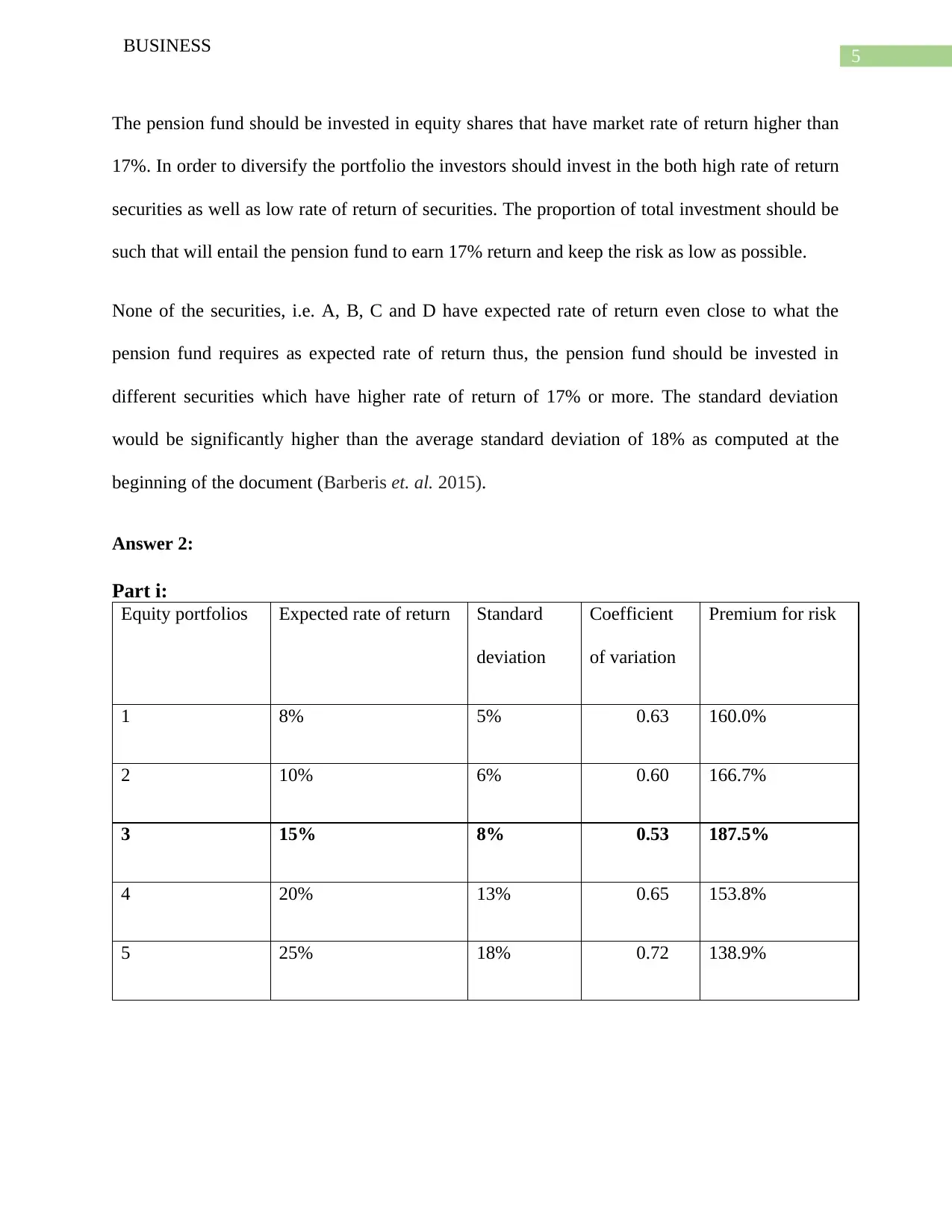
5
BUSINESS
The pension fund should be invested in equity shares that have market rate of return higher than
17%. In order to diversify the portfolio the investors should invest in the both high rate of return
securities as well as low rate of return of securities. The proportion of total investment should be
such that will entail the pension fund to earn 17% return and keep the risk as low as possible.
None of the securities, i.e. A, B, C and D have expected rate of return even close to what the
pension fund requires as expected rate of return thus, the pension fund should be invested in
different securities which have higher rate of return of 17% or more. The standard deviation
would be significantly higher than the average standard deviation of 18% as computed at the
beginning of the document (Barberis et. al. 2015).
Answer 2:
Part i:
Equity portfolios Expected rate of return Standard
deviation
Coefficient
of variation
Premium for risk
1 8% 5% 0.63 160.0%
2 10% 6% 0.60 166.7%
3 15% 8% 0.53 187.5%
4 20% 13% 0.65 153.8%
5 25% 18% 0.72 138.9%
BUSINESS
The pension fund should be invested in equity shares that have market rate of return higher than
17%. In order to diversify the portfolio the investors should invest in the both high rate of return
securities as well as low rate of return of securities. The proportion of total investment should be
such that will entail the pension fund to earn 17% return and keep the risk as low as possible.
None of the securities, i.e. A, B, C and D have expected rate of return even close to what the
pension fund requires as expected rate of return thus, the pension fund should be invested in
different securities which have higher rate of return of 17% or more. The standard deviation
would be significantly higher than the average standard deviation of 18% as computed at the
beginning of the document (Barberis et. al. 2015).
Answer 2:
Part i:
Equity portfolios Expected rate of return Standard
deviation
Coefficient
of variation
Premium for risk
1 8% 5% 0.63 160.0%
2 10% 6% 0.60 166.7%
3 15% 8% 0.53 187.5%
4 20% 13% 0.65 153.8%
5 25% 18% 0.72 138.9%
⊘ This is a preview!⊘
Do you want full access?
Subscribe today to unlock all pages.

Trusted by 1+ million students worldwide
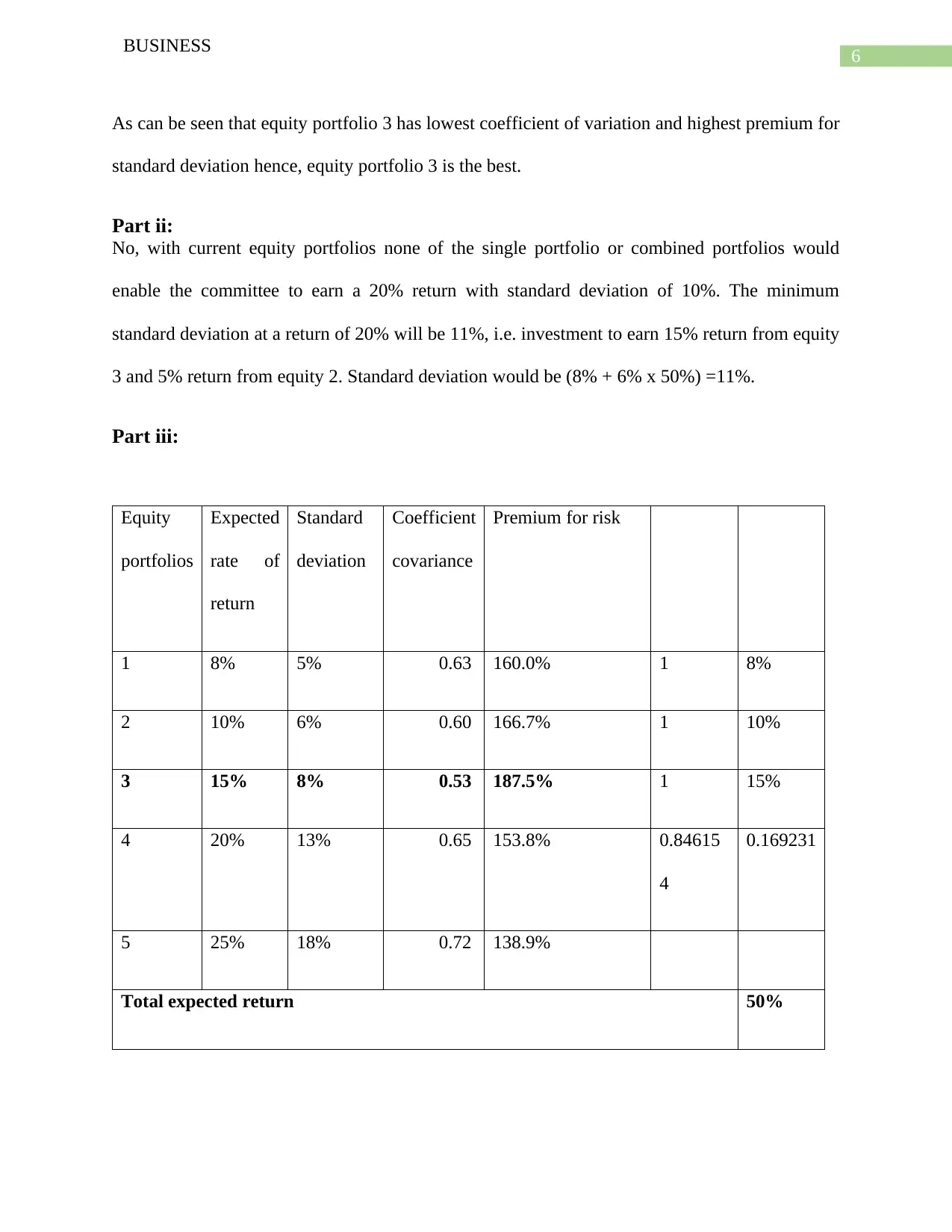
6
BUSINESS
As can be seen that equity portfolio 3 has lowest coefficient of variation and highest premium for
standard deviation hence, equity portfolio 3 is the best.
Part ii:
No, with current equity portfolios none of the single portfolio or combined portfolios would
enable the committee to earn a 20% return with standard deviation of 10%. The minimum
standard deviation at a return of 20% will be 11%, i.e. investment to earn 15% return from equity
3 and 5% return from equity 2. Standard deviation would be (8% + 6% x 50%) =11%.
Part iii:
Equity
portfolios
Expected
rate of
return
Standard
deviation
Coefficient
covariance
Premium for risk
1 8% 5% 0.63 160.0% 1 8%
2 10% 6% 0.60 166.7% 1 10%
3 15% 8% 0.53 187.5% 1 15%
4 20% 13% 0.65 153.8% 0.84615
4
0.169231
5 25% 18% 0.72 138.9%
Total expected return 50%
BUSINESS
As can be seen that equity portfolio 3 has lowest coefficient of variation and highest premium for
standard deviation hence, equity portfolio 3 is the best.
Part ii:
No, with current equity portfolios none of the single portfolio or combined portfolios would
enable the committee to earn a 20% return with standard deviation of 10%. The minimum
standard deviation at a return of 20% will be 11%, i.e. investment to earn 15% return from equity
3 and 5% return from equity 2. Standard deviation would be (8% + 6% x 50%) =11%.
Part iii:
Equity
portfolios
Expected
rate of
return
Standard
deviation
Coefficient
covariance
Premium for risk
1 8% 5% 0.63 160.0% 1 8%
2 10% 6% 0.60 166.7% 1 10%
3 15% 8% 0.53 187.5% 1 15%
4 20% 13% 0.65 153.8% 0.84615
4
0.169231
5 25% 18% 0.72 138.9%
Total expected return 50%
Paraphrase This Document
Need a fresh take? Get an instant paraphrase of this document with our AI Paraphraser

7
BUSINESS
Thus, total expected return would be 50% with 30% standard deviation.
Part iv:
Expected rate of return with equal weightage is calculated below:
Equity
portfolio
s
Expected
rate of
return
Standard
deviation
Weightage
investment
Proportionate
return
1 8% 5% 0.2 0.016
2 10% 6% 0.2 0.020
3 15% 8% 0.2 0.030
4 20% 13% 0.2 0.040
5 25% 18% 0.2 0.050
Expected rate of return 0.156
Expected rate of return of weightage is 15.60%.
Answer 3:
Part i:
BUSINESS
Thus, total expected return would be 50% with 30% standard deviation.
Part iv:
Expected rate of return with equal weightage is calculated below:
Equity
portfolio
s
Expected
rate of
return
Standard
deviation
Weightage
investment
Proportionate
return
1 8% 5% 0.2 0.016
2 10% 6% 0.2 0.020
3 15% 8% 0.2 0.030
4 20% 13% 0.2 0.040
5 25% 18% 0.2 0.050
Expected rate of return 0.156
Expected rate of return of weightage is 15.60%.
Answer 3:
Part i:
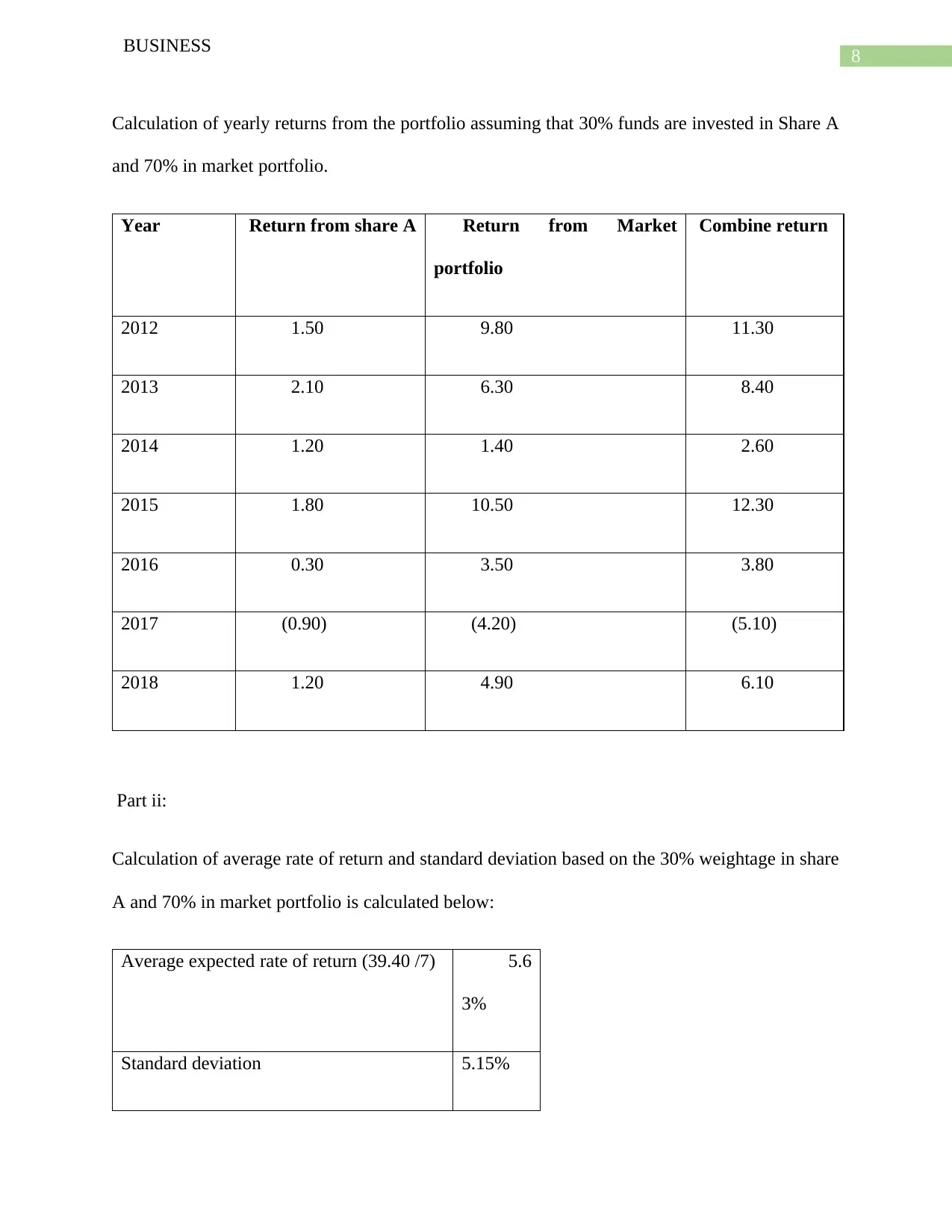
8
BUSINESS
Calculation of yearly returns from the portfolio assuming that 30% funds are invested in Share A
and 70% in market portfolio.
Year Return from share A Return from Market
portfolio
Combine return
2012 1.50 9.80 11.30
2013 2.10 6.30 8.40
2014 1.20 1.40 2.60
2015 1.80 10.50 12.30
2016 0.30 3.50 3.80
2017 (0.90) (4.20) (5.10)
2018 1.20 4.90 6.10
Part ii:
Calculation of average rate of return and standard deviation based on the 30% weightage in share
A and 70% in market portfolio is calculated below:
Average expected rate of return (39.40 /7) 5.6
3%
Standard deviation 5.15%
BUSINESS
Calculation of yearly returns from the portfolio assuming that 30% funds are invested in Share A
and 70% in market portfolio.
Year Return from share A Return from Market
portfolio
Combine return
2012 1.50 9.80 11.30
2013 2.10 6.30 8.40
2014 1.20 1.40 2.60
2015 1.80 10.50 12.30
2016 0.30 3.50 3.80
2017 (0.90) (4.20) (5.10)
2018 1.20 4.90 6.10
Part ii:
Calculation of average rate of return and standard deviation based on the 30% weightage in share
A and 70% in market portfolio is calculated below:
Average expected rate of return (39.40 /7) 5.6
3%
Standard deviation 5.15%
⊘ This is a preview!⊘
Do you want full access?
Subscribe today to unlock all pages.

Trusted by 1+ million students worldwide

9
BUSINESS
Part iii:
Calculation beta of stock A is provided below:
Year Return from share A Return from Market portfolio
2012 1.50 9.80
2013 2.10 6.30
2014 1.20 1.40
2015 1.80 10.50
2016 0.30 3.50
2017 (0.90) (4.20)
2018 1.20 4.90
7.20 32.20
Average return 1.03 4.60
Beta of stock A (1.03/4.60) 0.22
Answer 4:
Bond Market value
BUSINESS
Part iii:
Calculation beta of stock A is provided below:
Year Return from share A Return from Market portfolio
2012 1.50 9.80
2013 2.10 6.30
2014 1.20 1.40
2015 1.80 10.50
2016 0.30 3.50
2017 (0.90) (4.20)
2018 1.20 4.90
7.20 32.20
Average return 1.03 4.60
Beta of stock A (1.03/4.60) 0.22
Answer 4:
Bond Market value
Paraphrase This Document
Need a fresh take? Get an instant paraphrase of this document with our AI Paraphraser
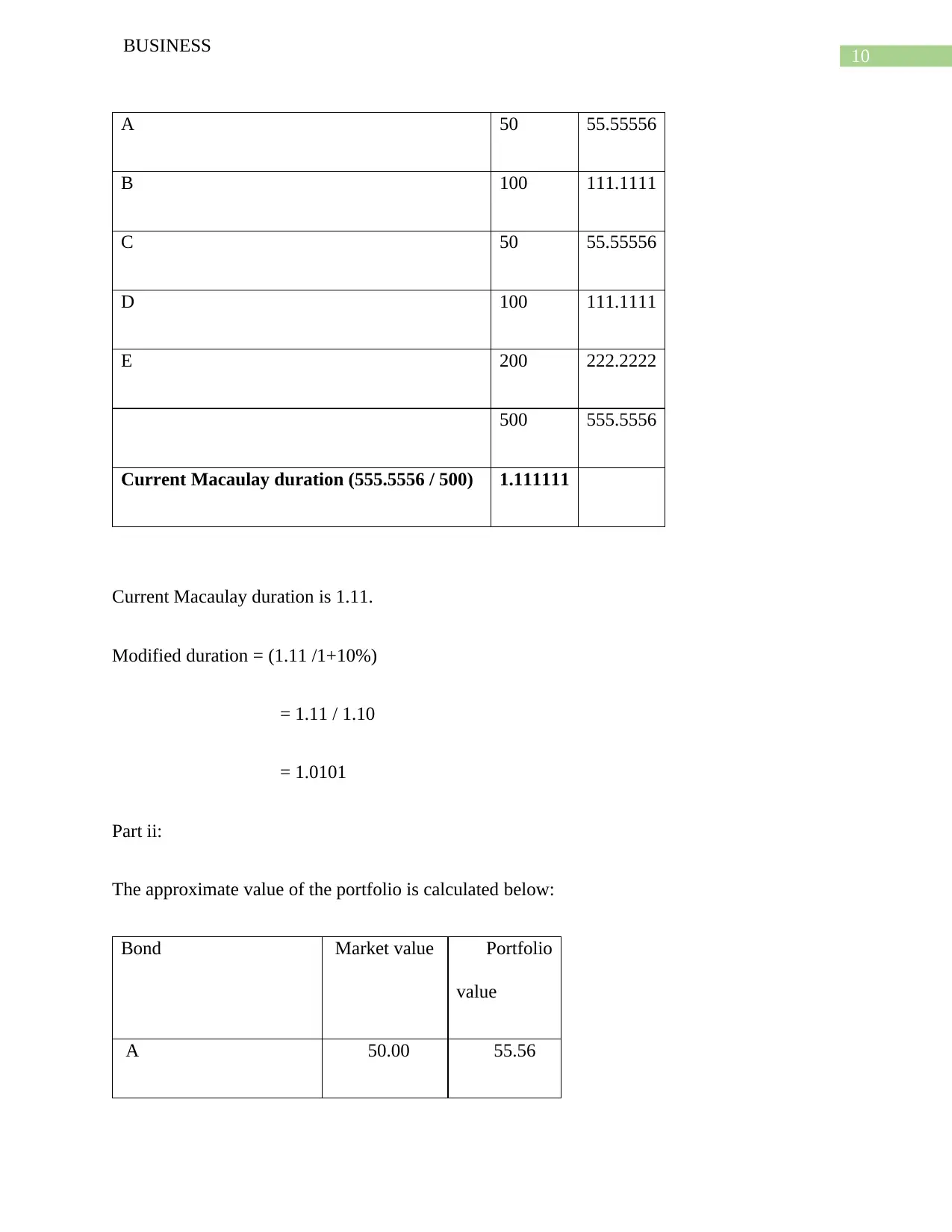
10
BUSINESS
A 50 55.55556
B 100 111.1111
C 50 55.55556
D 100 111.1111
E 200 222.2222
500 555.5556
Current Macaulay duration (555.5556 / 500) 1.111111
Current Macaulay duration is 1.11.
Modified duration = (1.11 /1+10%)
= 1.11 / 1.10
= 1.0101
Part ii:
The approximate value of the portfolio is calculated below:
Bond Market value Portfolio
value
A 50.00 55.56
BUSINESS
A 50 55.55556
B 100 111.1111
C 50 55.55556
D 100 111.1111
E 200 222.2222
500 555.5556
Current Macaulay duration (555.5556 / 500) 1.111111
Current Macaulay duration is 1.11.
Modified duration = (1.11 /1+10%)
= 1.11 / 1.10
= 1.0101
Part ii:
The approximate value of the portfolio is calculated below:
Bond Market value Portfolio
value
A 50.00 55.56

11
BUSINESS
B 100.00 111.11
C 50.00 55.56
D 100.00 111.11
E 200.00 222.22
Approximate value of the portfolio 555.56
Part iii:
In such case the bond manager should issue new bonds at low coupon rate to discharge the old
bonds issued at higher coupon rates.
Answer 5:
Part i:
Bond 1
Year Cash flow Period X cash flow PV Factor @10% pa Present value of inflow
1 9 9 0.909091 8.181818182
2 9 18 0.826446 14.87603306
3 9 27 0.751315 20.28549962
4 9 36 0.683013 24.58848439
5 9 45 0.620921 27.94145954
BUSINESS
B 100.00 111.11
C 50.00 55.56
D 100.00 111.11
E 200.00 222.22
Approximate value of the portfolio 555.56
Part iii:
In such case the bond manager should issue new bonds at low coupon rate to discharge the old
bonds issued at higher coupon rates.
Answer 5:
Part i:
Bond 1
Year Cash flow Period X cash flow PV Factor @10% pa Present value of inflow
1 9 9 0.909091 8.181818182
2 9 18 0.826446 14.87603306
3 9 27 0.751315 20.28549962
4 9 36 0.683013 24.58848439
5 9 45 0.620921 27.94145954
⊘ This is a preview!⊘
Do you want full access?
Subscribe today to unlock all pages.

Trusted by 1+ million students worldwide
1 out of 23
Related Documents
Your All-in-One AI-Powered Toolkit for Academic Success.
+13062052269
info@desklib.com
Available 24*7 on WhatsApp / Email
![[object Object]](/_next/static/media/star-bottom.7253800d.svg)
Unlock your academic potential
Copyright © 2020–2025 A2Z Services. All Rights Reserved. Developed and managed by ZUCOL.




